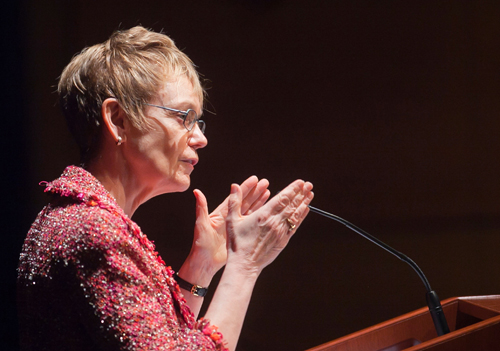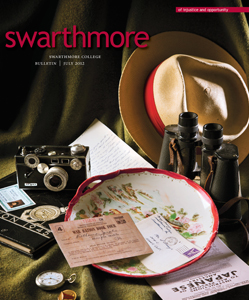Sharing our Commitment to the Liberal Arts
Swarthmoreans Connect With Other Higher Ed Leaders to Explore Challenges and Best Practices

This spring Swarthmore and Lafayette Colleges jointly sponsored a conference, “The Future of the Liberal Arts in America and its Leadership Role in Education Around the World,” engaging more than 230 college presidents, provosts, and foundation and association officers from around the United States and the United Kingdom. The conference, held in Easton, Pa., and generously funded by the Mellon Foundation, was the first of its type to focus on liberal arts colleges and draw upon the experience and wisdom of the leadership of these fine institutions.
My colleague Lafayette President Daniel Weiss and I conceived of the conference in order to analyze key environmental factors and internal drivers that affect the sustainability of residential liberal arts colleges; to discover what existing pilots or best practices hold promise for future development; and to explore new narratives of the liberal arts to guide undergraduate education in the 21st century.
Our hope in holding the conference was to stimulate leadership among presidents and others, to address publically the key issues in higher education, and to identify some of the incredible initiatives going on at our colleges. We presidents have been silent for too long in response to the critics about the exciting evolution occurring on our campuses.
The conference demonstrated the abiding, deep commitment we share to liberal arts education and the reason for that commitment: Our schools prepare citizen-leaders who can help build a more democratic culture and who are able to infuse that culture with the values of civility and inclusivity so lacking on the national and international stage. Our campuses also provide the space to concretely model community at a time in which many feel disconnected from any greater sense of belonging than they experience with their own families and friends. During my keynote address (bit.ly/distinctlyamerican) I focused on the need to create a new narrative that reflects a wonderful expansion of support for intellectual agility and ethical leadership and also invokes the need to support and guide the new ways of teaching, learning, and living in colleges that “incubate” new models of community in the 21st century.
Among those attending the conference were five Swarthmore faculty members who are on the steering committee developing Swarthmore’s Institute for the Future of the Liberal Arts, and Suzanne Welsh, our vice president for finance who made a presentation on the financial sustainability of our model. Here, in their words, are some core concepts gleaned from the conference:
• Two ideas from the conference particularly resonated with me. Keynote speaker William Bowen urged us to continue to “distinguish education from training”—especially in the current economic climate—and to resist the temptation to merely provide credentials as opposed to a holistic education. Furthermore, as suggested by Daniel Weiss, we should work hard to advance the aspects of a liberal arts education that make us distinctive. For example, at Bryn Mawr, students can take so-called “360-degree courses” which cut across disciplinary boundaries and include travel to learn about science, culture, and politics in situ, around the globe.—Matt Zucker, assistant professor of engineering
• “Collaboration” seemed to be one of the magic words. Many speakers noted that liberal arts colleges have traditionally been aloof from each other, preferring to develop a sense of individual distinctiveness. I agree that it’s time to challenge that attitude. I was impressed by the range of innovative programs and ideas at other colleges. Many colleges with fewer resources than Swarthmore appear more flexible and imaginative than we have been. The conference was a good start toward learning from our colleagues and contributing our own ideas about some shared challenges.—Tim Burke, professor of history
• One of the most exciting things to come out of this conference was the idea of partnering with business and the professions. Working with these communities gives our students opportunities to apply in new ways the knowledge, problem-solving skills, and ethical intelligence they develop at Swarthmore. Macalester College, for instance, developed a partnership with the Mayo Clinic that pairs teams of students in biochemistry, economics, and psychology with inventors working on new ideas. The students analyze the science behind the new ideas, propose possible applications, and make recommendations on whether or not to proceed. Partnerships such as these not only provide our students with valuable problem-based learning experiences, they also demonstrate to our community partners and publics the extraordinary value of a mind and character trained in the liberal arts.—Patricia Reilly, associate provost and associate professor of art history
• Residential liberal arts institutions are wrestling mightily with how to think about, respond to, and most effectively engage technology. We live in an era of flipped classrooms, massive open online courses, and online lectures while private entities, higher education partnerships, and individuals are developing innovative new tools for authoring and distributing entire courses online. The conference presented the opportunity to voice a few of the critical questions on the current advances in technology: Are these advances fundamentally different from past changes? How and for what reasons should Swarthmore and similar institutions evolve in response to various technologies? Ultimately, the conference signaled important work ahead in an area crucial to the future of residential liberal arts education.—Garikai Campbell ’90, associate professor of mathematics
• The pressure to assess learning outcomes has swept across the landscape of higher education like a tsunami. It has touched all of us at Swarthmore. Against this backdrop, I was struck by a thought shared by John McCardell, president of Sewanee. Looking ahead to the liberal arts curriculum of the future, he noted the enduring value of giving students a chance to learn apart from evaluation. As Swarthmore looks toward implementation of its strategic plan, I hope that we will continue to provide the kind of educational opportunities that blur the line between work and play.—Philip Jefferson, professor of economics
• During the last decade, higher education costs have increased faster as family incomes across all quintiles have failed to keep up with inflation. Conference participants felt that this has caused a major shift in public perception about costs of higher education—particularly since the changes have been most pronounced in the public institutions that 70 percent of all college students attend. There was renewed commitment to focus resources on core program priorities and accessibility (financial aid) rather than recreational climbing walls. Participants saw promise in greater collaboration among institutions and in the use of technology in pedagogy so that faculty can focus on student engagement, rather than information delivery.—Suzanne P. Welsh, vice president for finance and treasurer
So what’s next?
Many of the presidents are already talking about future meetings, both virtual and real. Dan Weiss (who, quite fortuitously, was named the next president of Haverford College in May) and I have been asked to make a presentation at the next Council of Independent Colleges Presidents’ Institute. We are also developing a book that will feature essays by each of the conference presenters.
On our campus, and as a result of the strategic planning process, this fall we will begin a “soft pilot” of the Institute for the Liberal Arts. The institute is a response to the desire of many on our faculty to develop more cross-disciplinary collaborations devoted to curricular and scholarly innovation. It also evolved from the concerns of many in our community that the continuing value and relevance of the liberal arts must be articulated clearly and that Swarthmore has a leadership role to play in advancing that case.
As Swarthmore’s Institute for the Liberal Arts embarks on its maiden voyage, we will look to support short-term and long-term work that knits faculty together across the disciplines, what we are calling “collaboratories”—existing clusters of cross-disciplinary work that do not correspond neatly to disciplines or formal interdisciplinary programs. We also will look to promote a rigorous self-examination of what the concept “liberal arts” means to us as a community and, through outside speakers and symposia, facilitate inquiries into the institutional and intellectual histories of this idea. If successful, the institute can help guide our future directions as well as shape the continuing discourse, as we seek to strengthen the role of the liberal arts in creating the citizen-leaders so essential to the future of our nation and world.
 Email This Page
Email This Page